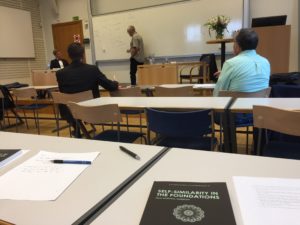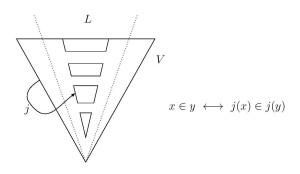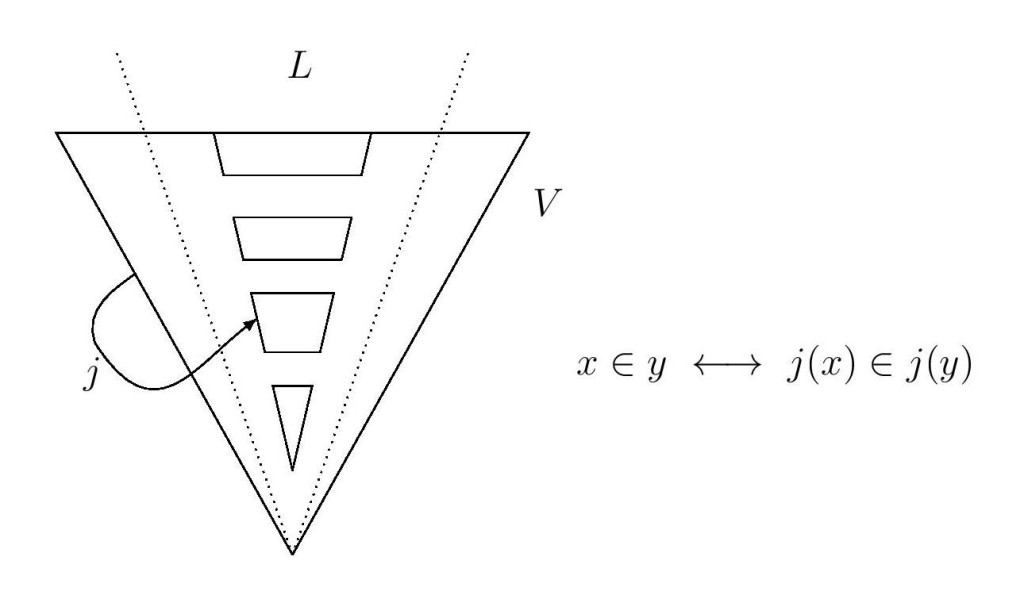[bibtex key=FuchsGitmanHamkins2017:IncomparableOmega1-likeModelsOfSetTheory]
This is joint work with Gunter Fuchs and Victoria Gitman.
Abstract. We show that the analogues of the Hamkins embedding theorems, proved for the countable models of set theory, do not hold when extended to the uncountable realm of -like models of set theory. Specifically, under the hypothesis and suitable consistency assumptions, we show that there is a family of many -like models of , all with the same ordinals, that are pairwise incomparable under embeddability; there can be a transitive -like model of ZFC that does not embed into its own constructible universe; and there can be an -like model of PA whose structure of hereditarily finite sets is not universal for the -like models of set theory.
In this article, we consider the question of whether the embedding theorems of my article, Every countable model of set theory embeds into its own constructible universe, which concern the countable models of set theory, might extend to the realm of uncountable models. Specifically, in that paper I had proved that (1) any two countable models of set theory are comparable by embeddability; indeed, (2) one countable model of set theory embeds into another just in case the ordinals of the first order-embed into the ordinals of the second; consequently, (3) every countable model of set theory embeds into its own constructible universe; and furthermore, (4) every countable model of set theory embeds into the hereditarily finite sets of any nonstandard model of arithmetic . The question we consider here is, do the analogous results hold for uncountable models? Our answer is that they do not. Indeed, we shall prove that the corresponding statements do not hold even in the special case of -like models of set theory, which otherwise among uncountable models often exhibit a special affinity with the countable models. Specifically, we shall construct large families of pairwise incomparable -like models of set theory, even though they all have the same ordinals; we shall construct -like models of set theory that do not embed into their own ; and we shall construct -like models of \PA\ that are not universal for all -like models of set theory.
The embedding theorems are expressed collectively in the theorem below. An embedding of one model of set theory into another is simply a function for which , for all , and in this case we say that embeds into ; note by extensionality that every embedding is injective. Thus, an embedding is simply an isomorphism of with its range, which is a submodel of . Although this is the usual model-theoretic embedding concept for relational structures, the reader should note that it is a considerably weaker embedding concept than commonly encountered in set theory, because this kind of embedding need not be elementary nor even -elementary, although clearly every embedding as just defined is elementary at least for quantifier-free assertions. So we caution the reader not to assume a greater degree of elementarity beyond quantifier-free elementarity for the embeddings appearing in this paper.
Theorem.
1. For any two countable models of set theory and , one of them embeds into the other.
2. Indeed, such an embeds into if and only if the ordinals of order-embed into the ordinals of .
3. Consequently, every countable model of set theory embeds into its own constructible universe .
4. Furthermore, every countable model of set theory embeds into the hereditary finite sets of any nonstandard model of arithmetic . Indeed, is universal for all countable acyclic binary relations.
One can begin to get an appreciation for the difference in embedding concepts by observing that ZFC proves that there is a nontrivial embedding , namely, the embedding recursively defined as follows
We leave it as a fun exercise to verify that for the embedding defined by this recursion. (See my paper Every countable model of set theory embeds into its own constructible universe; but to give a hint here for the impatient, note that every is nonempty and also ; it follows that inside we may identify the pair ; it follows that is injective and furthermore, the only way to have is from .} Contrast this situation with the well-known Kunen inconsistency, which asserts that there can be no nontrivial -elementary embedding . Similarly, the same recursive definition applied in leads to nontrivial embeddings , regardless of whether exists. But again, the point is that embeddings are not necessarily even -elementary, and the familiar equivalence of the existence of with a nontrivial “embedding” actually requires a -elementary embedding.)
We find it interesting to note in contrast to the theorem above that there is no such embedding phenomenon in the the context of the countable models of Peano arithmetic (where an embedding of models of arithmetic is a function preserving all atomic formulas in the language of arithmetic). Perhaps the main reason for this is that embeddings between models of PA are automatically -elementary, as a consequence of the MRDP theorem, whereas this is not true for models of set theory, as the example above of the recursively defined embedding shows, since this is an embedding, but it is not -elementary, in light of . For countable models of arithmetic , one can show that there is an embedding if and only if satisfies the -theory of and the standard system of is contained in the standard system of . It follows that there are many instances of incomparability. Meanwhile, it is a consequence of statement (4) that the embedding phenomenon recurs with the countable models of finite set theory , that is, with for , since all nonstandard such models are universal for all countable acyclic binary relations, and so in the context of countable models of there are precisely two bi-embeddability classes, namely, the standard model, which is initial, and the nonstandard countable models, which are universal.
Our main theorems are as follows.
Theorem.
1. If holds and ZFC is consistent, then there is a family of many pairwise incomparable -like models of ZFC, meaning that there is no embedding between any two distinct models in .
2. The models in statement (1) can be constructed so that their ordinals order-embed into each other and indeed, so that the ordinals of each model is a universal -like linear order. If ZFC has an -model, then the models of statement (1) can be constructed so as to have precisely the same ordinals.
3. If holds and ZFC is consistent, then there is an -like model and an -like model such that does not embed into .
4. If there is a Mahlo cardinal, then in a forcing extension of , there is a transitive -like model that does not embed into its own constructible universe .
Note that the size of the family in statement (1) is as large as it could possibly be, given that any two elements in a pairwise incomparable family of structures must be non-isomorphic and there are at most many isomorphism types of -like models of set theory or indeed of structures of size in any first-order finite language. Statement (2) shows that the models of the family serve as -like counterexamples to the assertion that one model of set theory embeds into another whenever the ordinals of the first order-embed into the ordinals of the second.
 University of Gothenburg profile | ar
University of Gothenburg profile | ar





 This will be an invited talk for the
This will be an invited talk for the 
